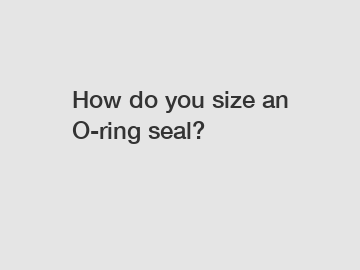How do you size an O-ring seal?
How do you size an O-ring seal?
O-ring seals are essential components used in various industries to prevent leakage and ensure proper sealing of fluids or gases in a system. These small circular rings are designed to fit into specific grooves and create a tight seal when compressed between two mating surfaces. However, it is crucial to size an O-ring correctly to ensure optimal performance and effectiveness. In this article, we will discuss the steps involved in sizing an O-ring seal and the importance of getting it right.
Understanding O-ring dimensions.

Sizing an O-ring begins with understanding its dimensions. O-rings are typically measured using three primary dimensions: inner diameter (ID), outer diameter (OD), and cross-section diameter (CS). The ID is the measurement taken from the inside edge of the ring, while the OD is the measurement from the outside edge. The CS represents the thickness or diameter of the O-ring.
Selecting the appropriate groove design.
The groove design plays a crucial role in determining the overall performance of an O-ring seal. It is essential to choose the right groove dimensions and shape to ensure proper sealing. The groove must be designed with specific tolerances to accommodate the O-ring's cross-section diameter and provide the necessary compression for a tight seal. Failure to select the appropriate groove design can lead to O-ring failure, leakage, and potential system malfunctions.
Determining the necessary compression.
Proper compression of the O-ring is critical for an effective seal. Insufficient compression may result in inadequate sealing, while excessive compression can cause premature failure or damage to the O-ring. The required compression is typically determined based on the specific application and the material properties of the O-ring. It is important to consult O-ring manufacturers or industry standards to determine the appropriate compression range for optimal sealing performance.
Considerations for temperature and material compatibility.
Temperature and material compatibility are vital factors to consider when sizing an O-ring seal. Different materials exhibit varying degrees of resistance to temperature extremes, chemicals, and other environmental factors. It is crucial to select an O-ring material that can withstand the expected temperature range and chemical exposure in the intended application. Additionally, compatibility between the O-ring material and the mating surfaces is essential to prevent degradation, swelling, or chemical reactions that could compromise the seal.
Consult O-ring size charts or software.
To simplify the sizing process, O-ring manufacturers provide size charts or software that engineers and designers can consult. These tools typically provide comprehensive information about O-ring dimensions, groove design recommendations, material compatibility, and acceptable compression ranges. By inputting the required parameters, such as ID, OD, and CS dimensions, engineers can quickly determine the appropriate O-ring size and compatible materials, saving time and ensuring accuracy.
In conclusion, sizing an O-ring seal is a critical step in ensuring its effectiveness and preventing leakage in industrial systems. By understanding the dimensions, selecting the appropriate groove design, determining the necessary compression, considering temperature and material compatibility, and consulting size charts or software, engineers and designers can accurately size O-rings for optimal performance. For further assistance or to source O-ring seals from reliable suppliers, feel free to contact us. Our knowledgeable team is ready to help you find the right solutions for your sealing needs.
For more information, please visit PVC Trim Strip, PVC Trim Strip, Railway Sealing Strip.
203
0
0


Comments
All Comments (0)